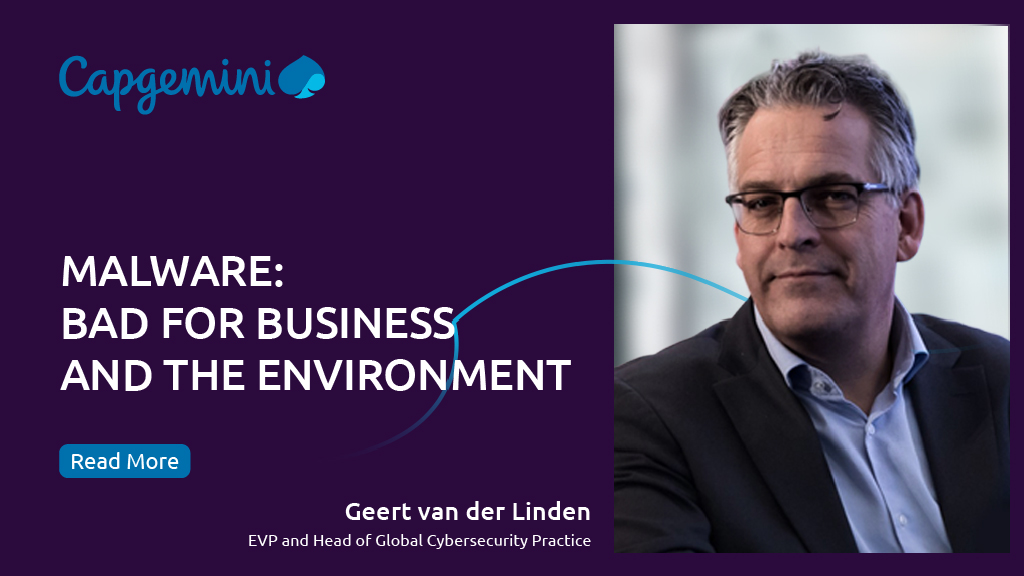Malware: Bad for business and the environment
Blog: Capgemini CTO Blog
As we collectively work towards achieving targets laid out in the 2030 climate and energy framework, organizations around the world are implementing their own ambitious sustainability goals. While some have been proudly holding the sustainability baton for years, others are quickly gaining pace in the relay.
This acceleration comes at the same time as a digital revolution, which often jars against the drive to lower our environmental footprint. Why? Because as we become more and more reliant on digitization, we also produce more and more data. Processing that data consumes electricity, which if not done efficiently, can cause energy consumption to skyrocket.
However, what happens when that data isn’t secure? We often discuss the risks that a data breach imposes on a business, but we rarely consider the implications on the environment.
The risks of malware
The harsh reality is that malware doesn’t only threaten data security – it can also have a direct impact on sustainability initiatives and impede enterprise climate targets. There are numerous attacks that cause detrimental effects on the environment:
-
DDOS attacks
DDOS attacks consume extortionate amounts of energy. The attack often starts with that suspicious link or download that you accidently click on. Before you know it, you have a botnet on your hands, rapidly sending fake traffic to a server or website. As the network becomes flooded with malicious traffic, it’s no longer able to operate normally. The malware quickly captures workstations causing computers across the network to run at full capacity, firing more and more requests to the server. Eventually, the server goes into overdrive as it tries to handle the mass of data requests it’s receiving.
From a business perspective, this means services and operations can grind to a halt. But from an energy perspective, it means consumption levels accelerate exponentially, undermining efficiency measures that may have been in place.
-
Production line sabotage
Cyber criminals are increasingly targeting production lines in an attempt to break into a company’s network. This can spell disaster for a factory, potentially rendering its entire production unfit for purpose. Malware can jeopardize the robust quality control procedures that ensure a product is being produced safely and meets standards.
For example, a factory producing automotive chemicals will have various digital checkpoints along the production line to ensure the product meets regulated levels. Malware can damage these checkpoints, making them unreliable and ineffective. This has a considerable knock-on effect: entire batches of product become unusable and must be discarded, the energy used becomes obsolete, and ultimately pollution and waste levels increase.
This was seen recently when one of the spirits brands suffered a ransomware attack. While the breach compromised the security of customer data, it also ground its factories to a halt. The drinks brand was unable to prove that its liquor met regulations and so had to discard batches of product.
-
Sustainable infrastructure warfare
For organizations that operate in sustainable infrastructure, any attacks will have a direct and devastating effect on the environment – a fact that certainly does not escape attackers, particularly the growing number of state sponsored ones.
Take, for example, a water works company. A water works ensures that water is safe and prevents pollution from entering our rivers. It processes water to ensure it is clean and will monitor pollution levels at all times. If that system is compromised, then the water is no longer guaranteed to be clean or free of pollution, creating astronomical environmental, economic, and societal consequences.
By actively protecting infrastructure against malicious attacks, we are simultaneously protecting the environment – and the communities it supports.
An end-to-end solution
Given the widespread impact of a potential attack, organizations cannot afford any gaps in their cybersecurity. The most effective way to protect your business is through end-to-end encryption, which enables you to manage the full lifecycle of your security.
At Capgemini, we split our end-to-end solution into three key areas:
- Define your security objectives and procedures; ensure cybercriminals can’t get through the back door.
- Protect your assets; implement the right security solutions for your business.
- Defend the enterprise; detect and react in advance of cyberattacks.
By taking this approach, you can ensure your business is secure and quick to respond in the event of a breach. The sooner you act on malware, the faster you stop the spread of infection and avoid the associated risks. It’s this action that ensures cybersecurity can be an enabler for sustainability.
Follow Geert van der Linden on LinkedIn and Twitter.
Leave a Comment
You must be logged in to post a comment.








